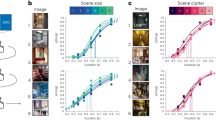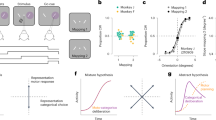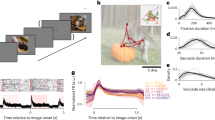Abstract
The perception/action model states that vision for perception and vision for action are processed in separate pathways. This model was inspired by observations in patient D.F. who seemed unable to use vision for perceptual tasks while retaining 'normal' visuomotor capacity. I found that D.F.'s performance is preserved in perceptual and visuomotor tasks when the required spatial information is hand-centered and impaired when the information is object-centered.
This is a preview of subscription content, access via your institution
Access options
Subscribe to this journal
Receive 12 print issues and online access
$209.00 per year
only $17.42 per issue
Buy this article
- Purchase on Springer Link
- Instant access to full article PDF
Prices may be subject to local taxes which are calculated during checkout


Similar content being viewed by others
References
Goodale, M.A. & Milner, A.D. Trends Neurosci. 15, 20–25 (1992).
Ungerleider, L.G. & Mishkin, M. in Analysis of Visual Behavior (eds. Ingle, D.J., Goodale, M.A. & Mansfield, R.J.) 549–586 (MIT Press, Cambridge, Massachusetts, 1982).
Milner, A.D. et al. Brain 114, 405–428 (1991).
Bruno, N. Trends Cogn. Sci. 5, 379–382 (2001).
Franz, V.H., Fahle, M., Bulthoff, H.H. & Gegenfurtner, K.R. J. Exp. Psychol. Hum. Percept. Perform. 27, 1124–1144 (2001).
Glover, S. Trends Cogn. Sci. 6, 288–292 (2002).
Rossetti, Y., Pisella, L. & Vighetto, A. Exp. Brain Res. 153, 171–179 (2003).
Norman, J. Behav. Brain Sci. 25, 73–96 (2002).
Goodale, M.A. & Milner, A.D. Sight Unseen: Explorations in Conscious and Unconscious Vision (Oxford Univ. Press, Oxford, 2004).
Crawford, J.R. & Howell, D.C. Clin. Neuropsychol. 12, 482–486 (1998).
Carey, D.P., Harvey, M. & Milner, A.D. Neuropsychologia 34, 329–337 (1996).
Jacob, P. & Jeannerod, M. Ways of Seeing: the Scope and Limits of Visual Cognition (Oxford Univ. Press, Oxford, 2003).
Milner, A.D. & Goodale, M.A. The Visual Brain in Action (Oxford Univ. Press, Oxford, 1995).
Pisella, L. et al. Nat. Neurosci. 3, 729–736 (2000).
Khan, A.Z. et al. Nat. Neurosci. 8, 418–420 (2005).
Acknowledgements
I thank D.F. for her participation. This work was supported by the Wolfson Research Institute and a grant from the Leverhulme Trust (grant F/00128/O).
Author information
Authors and Affiliations
Corresponding author
Ethics declarations
Competing interests
The author declares no competing financial interests.
Supplementary information
Supplementary Table 1
Proprioceptive performance of patient DF and controls. (PDF 11 kb)
Rights and permissions
About this article
Cite this article
Schenk, T. An allocentric rather than perceptual deficit in patient D.F.. Nat Neurosci 9, 1369–1370 (2006). https://doi.org/10.1038/nn1784
Received:
Accepted:
Published:
Issue Date:
DOI: https://doi.org/10.1038/nn1784
This article is cited by
-
Integration of landmark and saccade target signals in macaque frontal cortex visual responses
Communications Biology (2023)
-
Spatial coding for action across spatial scales
Nature Reviews Psychology (2022)
-
Implicit biases in visually guided action
Synthese (2021)
-
The role of perception and action on the use of allocentric information in a large-scale virtual environment
Experimental Brain Research (2020)
-
Grasping and perception are both affected by irrelevant information and secondary tasks: new evidence from the Garner paradigm
Psychological Research (2020)



